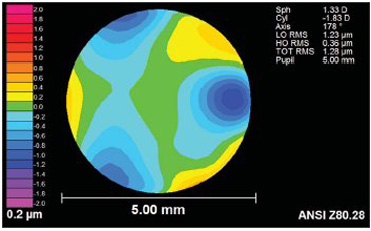Corneal First Surface Wavefront Aberrations Before and After Pterygium Surgery
PURPOSE: To determine the higher order aberrations at the corneal fi rst surface before and after surgery for pterygium.
METHODS: Data were drawn from a longitudinal study of patients undergoing pterygium excision at Royal Victoria Infirmary, Newcastle upon Tyne, England between September 1998 and May 2004. Corneal topography was taken with the TMS-2 Topographic Modeling System (Computed Anatomy Corp) prior to and 6 months after surgery, exported to VOLPro software v7.08 (Sarver & Associates), and wavefront aberrations were derived for a 5.0-mm pupil using a 10th order Zernike polynomial expansion. Pre- to postoperative changes were assessed for significance using analyses of variance, and the relative risk of significant postoperative aberrations by pterygium size was determined.
RESULTS: Satisfactory corneal topography was available on 67 eyes (mean age 53.8 ±16.7 years [range: 25-86 years]). The root-mean-square (RMS) fi t error in preoperative eyes was 0.15▒0.10 Ám. Preoperatively, the total higher order RMS wavefront aberration was 0.94 ±0.83 Ám. All Zernike modes were elevated, with trefoil being the major contributor 0.52▒0.50 Ám. Pterygium excision significantly reduced wavefront aberrations across all modes and orders (F1,129=6.7 to 22.6, P<.01): total higher order RMSpostop 0.45 ±0.35 Ám. Cases with visually significant postoperative aberrations occurred and were more likely with larger pterygia: relative risk compared to pterygia 1.0 to 1.9 mm was 1.3 for 2.0 to 2.9 mm, 8.5 for 3.0 to 3.9 mm, 13.3 for 4.0 to 4.9 mm, and 10.2 for 5.0 to 5.9 mm.

Figure 2. The average higher order wavefront error removed by
pterygium excision (oriented for a right eye with a nasal pterygium).
Note the pattern is dominated by the three-lobed appearance of trefoil.
CONCLUSIONS: Zernike polynomial fitting well describes wavefront aberrations in eyes with pterygia. Pterygia are associated with wavefront aberrations, especially trefoil, but these were largely eliminated by surgery. Earlier excision of pterygia reduces the likelihood of significant residual aberrations.
J Refract Surg. November 2006;22:921-925.
Konrad Pesudovs1 PhD
Francisco C. Figueiredo2 MD
1 NH&MRC Centre for Clinical Eye Research, Department of Ophthalmology, Flinders Medical Centre and Flinders University, Bedford Park, South Australia, Australia
2 Cornea Service, Department of Ophthalmology, Royal Victoria Infirmary, Newcastle upon Tyne, United Kingdom

Wavefront aberrations after Pterygium surgery as PDF (275 Kb)
![]()
Index of Papers
[ Welcome ][ Publications ]

